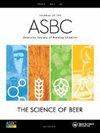铜基杀菌剂处理对美国东北部啤酒花品质的影响
IF 1.8
4区 农林科学
Q4 BIOTECHNOLOGY & APPLIED MICROBIOLOGY
Journal of the American Society of Brewing Chemists
Pub Date : 2021-07-19
DOI:10.1080/03610470.2021.1937900
引用次数: 0
摘要
啤酒花的品质在很大程度上取决于其风味和香气化合物的含量。这些化合物的浓度各不相同,并受到农业实践的影响。先前的研究发现,波尔多混合酒的应用可能会通过改变品种硫醇的浓度来影响啤酒花的香气品质。除波尔多混合剂外,铜杀菌剂在美国太平洋西北部以外的啤酒花产区的影响还有待评估。本文研究了氢氧化铜(II)杀菌剂的使用频率对美国东北部啤酒花品质指标的影响。与施用频率无关,施用铜杀菌剂显著提高了啤酒花球果总铜含量;然而,传统的啤酒花品质指标,包括产量、精油成分和酸含量,没有受到影响。啤酒消费者无法根据香气区分传统干啤酒花和铜处理啤酒花的啤酒,但能够根据入口感知来区分。这些发现表明,在美国东北部种植的啤酒花中,使用氢氧化铜(II)来减轻真菌病原体的影响,不太可能对最终的啤酒花产量、酸含量或硫醇质量产生不利影响。本文章由计算机程序翻译,如有差异,请以英文原文为准。
Effect of Copper-Based Fungicide Treatments on the Quality of Hop Produced in the Northeastern United States
Abstract The quality of hops is dictated in large part by the content of flavor and aroma compounds. These compounds vary in concentration and are affected by agricultural practices. Previous research has found that the application of Bordeaux Mixture may impact the aroma quality of hops by altering concentrations of varietal thiols. The impact of copper fungicides other than Bordeaux Mixture and in hop production areas outside of the Pacific Northwest in the United States has yet to be evaluated. Herein we study the effects of application frequency of a copper (II) hydroxide fungicide on markers of hop quality in hops grown in the Northeastern United States. Copper fungicide application was found to significantly increase the total copper content of hop cones, regardless of application frequency; however, traditional markers of hop quality, including yield, essential oil composition, and acid content, were not affected. Beer consumers were unable to discriminate between beers dry-hopped with conventional or copper-treated hops based on aroma but were able to discriminate based on in-mouth perception. These findings suggest that the use of copper (II) hydroxide for the mitigation of fungal pathogens in hops grown in the Northeastern United States is unlikely to adversely affect final hop yield, acid content, or thiol quality.
求助全文
通过发布文献求助,成功后即可免费获取论文全文。
去求助
来源期刊

Journal of the American Society of Brewing Chemists
工程技术-生物工程与应用微生物
CiteScore
4.00
自引率
20.00%
发文量
41
审稿时长
3 months
期刊介绍:
The Journal of the American Society of Brewing Chemists publishes scientific papers, review articles, and technical reports pertaining to the chemistry, microbiology, and technology of brewing and distilling, as well as the analytical techniques used in the malting, brewing, and distilling industries.
 求助内容:
求助内容: 应助结果提醒方式:
应助结果提醒方式:


